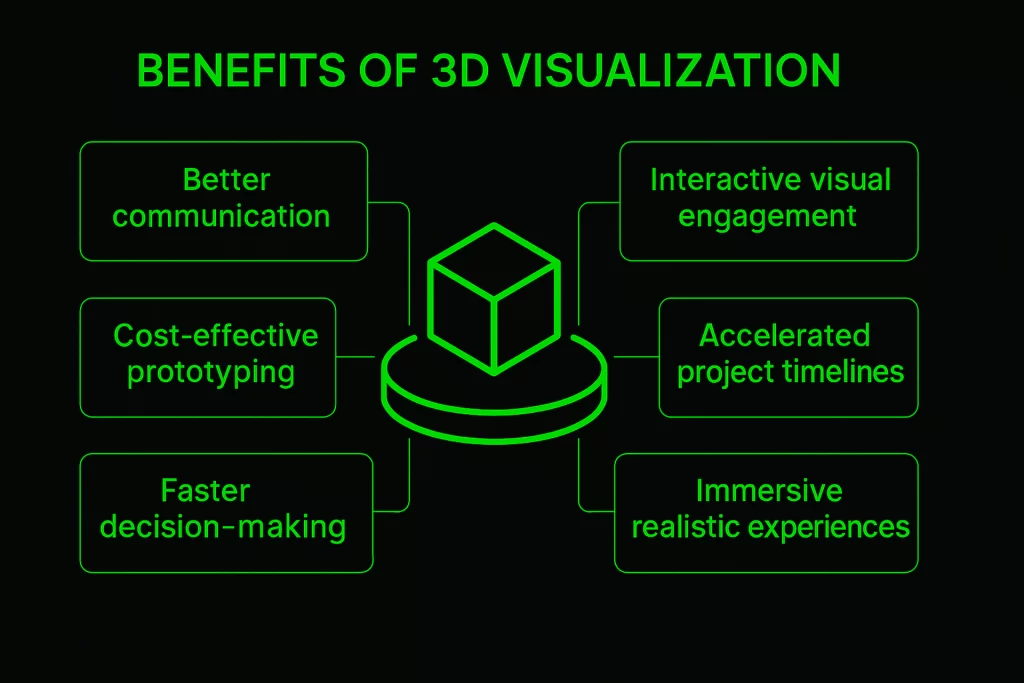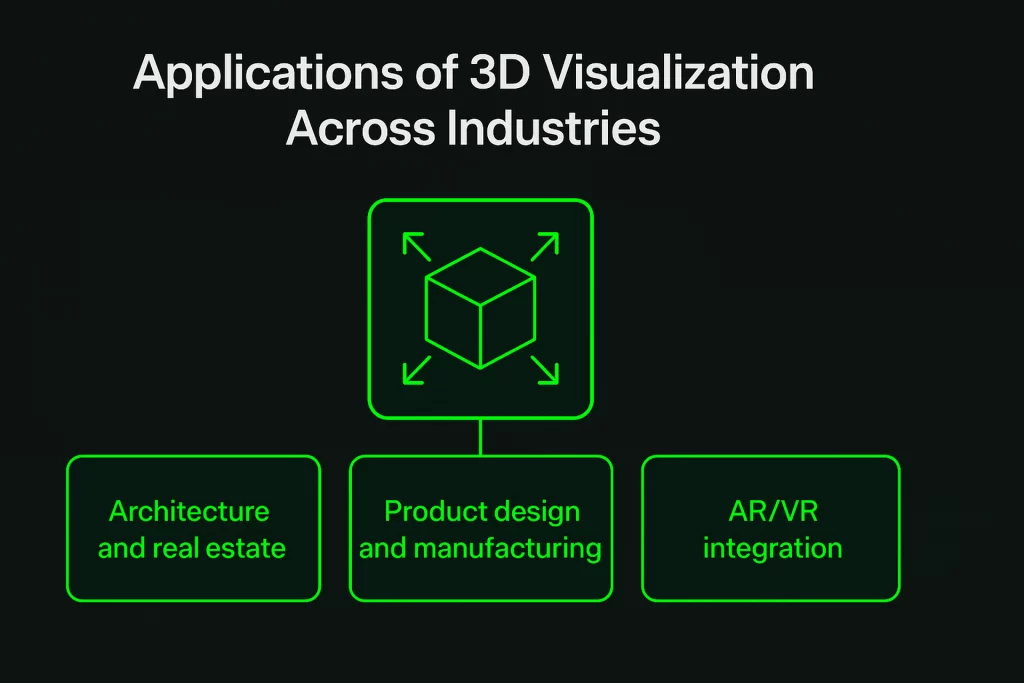3D visualization uses the raw 3D models as input and transforms them into visual outputs (like still images or interactive scenes) that humans can easily understand. It’s a broad process that often includes steps like modeling, rendering, and animation, whereas modeling alone is just one step in that pipeline. The end result is often stunning: a high‑quality image or interactive scene that communicates ideas much better than a flat sketch or a verbal description.
What Is 3D Visualization Technology?
The technique of creating and showing digital material in three dimensions is called 3D visualization technology. Basically, it’s about utilizing computer programs to make 3D models, pictures, or animations that seem genuine and let people view something as if it were real, even if it’s not there. If you’re wondering what 3D visualization means, it basically means using realistic 3D visuals to make an idea or design come to life.
Over the last several decades, this technology has gone from simple wireframe drawings to very detailed, lifelike images. It’s important to note that 3D visualization is not the same as just producing a CAD model. 3D modeling is the process of making a digital object with particular width, height, and depth. Visualization goes a step further by adding textures, colors, lighting, and context to make a finished picture or simulation.
How Does 3D Visualization Work?
You usually need specific 3D visualization software to do the different steps of 3D visualization. The first step is 3D modeling, in which artists or designers create a detailed digital representation of an item or space. In a way, they create a virtual “wireframe” that shows the object’s form in XYZ coordinates. You may make this model from scratch or use data from the actual world, such as architectural plans or CAD files for a product.
The next stage after making the basic model (or 3D design) is to add textures and materials. These are the elements on the surface that make the object appear authentic, such as the grain of wood on furniture or the skin on a character. Then, the virtual scene’s lighting is put up to show how light and shadows might fall. To make things seem genuine, this step is very important. Techniques like global illumination and physically based rendering assist make sure the light acts like it does in real life.
After modeling and setting up, rendering is the computer-driven process of making the final picture or animation from the 3D scene that has been built up. Rendering a high-quality picture used to take hours or even days since the program had to figure out how light interacts with surfaces, how reflections work, and how textures look in real life. Real-time rendering engines and powerful GPUs, on the other hand, make feedback considerably quicker now. In an interactive viewport, designers can typically see changes right away, which makes the entire process more creative and iterative. You may change a design and see the results right away with this real-time visualization, which speeds up development.
Benefits of 3D Visualization
3D visualization has a lot of benefits:
Better communication
People often say that a picture is worth a thousand words, and this is particularly true when it comes to design and planning. 3D visualization gives people a way to see things that everyone can grasp. A realistic model or setting may help team members, customers, or other stakeholders understand complicated concepts quickly and effectively. This makes it less likely that people would misinterpret each other since they are all physically viewing the same thing. For instance, architects may show customers a precise 3D representation of the inside of a building, and right away everyone understands what the design would look like – no need to use their imagination. A 3D model is a common reference for designers, engineers, and marketers in cross-functional teams. A well-made 3D model may really become a “single source of truth” that makes it easier for diverse departments to work together. This clear communication cuts down on back-and-forth and avoids expensive misunderstandings from happening in the future.
Cost‑effective prototyping
It might take a lot of time and money to make actual prototypes or mock-ups. Companies may use 3D visualization to make virtual prototypes and try out ideas without having to spend a lot of money on actual materials and production. This is really helpful in areas like making and designing products. Engineers may improve the design in 3D, test out numerous versions, and only make a physical model when the design is almost done. This means they don’t have to make a new prototype every time they change it. This computerized method cuts down on waste and costs. Industry experts say that employing precise 3D drawings to show how a product will look and work early on may greatly reduce the number of actual prototypes that are required.
Faster decision‑making
People who have a stake in a project or product are more likely to make choices quickly and with more confidence when they can see the eventual result in detail. Seeing a realistic 3D model speeds up the decision-making process, whether it’s an executive giving the go-ahead for a new design or a buyer picking one product over another. The answer is simple: clear pictures make things easier to grasp. It’s far easier to understand a realistic model than a technical sketch or a written explanation. One research said that “3D visualization dramatically reduces the back-and-forth that slows down projects,” which makes it easier and quicker for everyone to make decisions.
Engagement via interactive visuals
3D interactive material doesn’t simply provide you with information; it also gets you involved. Keeping an audience or consumer interested may make a big difference for a company in today’s digital world. 3D visualization lets you engage with and get lost in the content in a way that static photos and text can’t. For instance, an online store that uses a 3D product configurator allows buyers to rotate the item, zoom in on details, and even change colors or features in real time. This kind of interaction automatically makes people more interested and keeps them browsing for longer. There is proof that people who look at interactive 3D spend a lot more time on a product page than those who look at flat graphics. That additional involvement isn’t only for enjoyment; it leads to improved business results. People are more likely to buy anything if they spend time customizing or looking at a 3D model. Customers are more inclined to buy anything after seeing it in 3D or augmented reality; that’s for sure. Interactive 3D images, like virtual showrooms or trade fair demonstrations, grab people’s interest even when they’re not shopping online. They make the viewer want to investigate, which makes the experience more memorable and helps them absorb the subject better. In marketing, 3D visualization gets those who are just watching to become active players, which is great for getting customers to interact with your brand.
Faster project deadlines
In practically every field, time equals money. Using 3D visualization helps a lot of projects get from idea to completion quicker. One reason is that judgments are made more quickly and mistakes are found sooner, both of which shorten the time frame. But the process itself also becomes better. Instead of needing to redraw schematics or wait for physical models, designers and engineers may quickly change a design by changing the 3D model and seeing the consequences right away. Sometimes, all it takes is one meeting to make changes that may have required days of debate. Everyone can look at the 3D visualization and agree on what has to be changed. Also, working together makes things better. Teams in various places may look at the same 3D model in a shared virtual environment or on cloud platforms, which cuts down on long email chains or travel for in-person meetings.
Realistic encounters that make you feel like you’re there
One of the most intriguing things about 3D visualization is that it lets you create experiences that are very immersive. This is when the technology moves beyond merely “seeing” to “feeling,” letting individuals digitally stroll into a space or use a product in a manner that seems genuine. Thanks to contemporary technology, 3D representations may now be used in virtual reality (VR) or augmented reality (AR) experiences, making them more realistic and immersive than ever before. For instance, architects may put on a VR headset and walk inside a building that hasn’t been finished yet. They can see the room at its real size and even look about as they would in real life. This immersive representation may show you design details or problems with space that a 2D plan wouldn’t show you.

Applications of 3D Visualization Across Industries
At first, 3D visualization was only used in some disciplines, including movies and video games. Now, however, it’s used in many other fields. Almost every sector that creates, manufactures, or sells anything may benefit from seeing it in 3D. Some of the most important industries are:
Architecture and real estate
Architects and designers utilize 3D rendering to make comprehensive pictures and walkthroughs of structures before they are built. This lets both the design team and the customers look at buildings from different points of view and make smart improvements early on. Property developers in real estate use high-quality 3D photos and virtual tours to show off houses and condominiums so that purchasers can see the area without having to be there in person. Listings that include virtual tours usually receive more views, sell quicker, and for more money than those that don’t.
Product design and manufacturing
Designers and makers of products employ 3D visualization at practically every level of the process. Before any actual prototypes are built, 3D models of early ideas and realistic CAD models that look like genuine things are developed for aesthetic assessment and practical simulations. In factories, augmented reality may put 3D models on top of actual objects to help with assembly or quality checks. There are now 3D models of furniture, electronics, and other things in many catalogs and adverts instead of pictures.
AR/VR integration
3D visualization naturally leads to augmented and virtual reality. Augmented reality (AR) lets buyers see things in their own location before they purchase them, while virtual reality (VR) lets them completely experience training or design critiques. These technologies are used in stores, for training, for maintenance, and for fun to make things more dynamic and interesting.

Future of 3D Visualization
As we get closer to 2026, new technologies like AI-assisted modeling, cloud-based collaboration, and real-time rendering will change the way we use 3D visualization. Sources say that AI is becoming an important part of 3D modeling software, allowing for automatic design ideas, mistake detection, and optimization. Cloud-based solutions let people work together in real time and keep track of different versions of files, which makes working together from a distance more productive. GPU technology and rendering engines are becoming better, making real-time visualization possible. This lets designers see results right away and speeds up the creative process in architecture, product design, gaming, and VR. Real-time rendering is already making things easier for users and speeding up operations. AI-powered rendering techniques help improve lighting and texturing, creating lifelike images rapidly by doing complicated math automatically.
Use Cases of 3D Visualization Technology
3D visualization is already being used in several fields for real-world purposes.
High-resolution renderings and virtual tours let customers look at structures before they are built in architecture and real estate. This makes it easier to make decisions and talk to each other.
In healthcare, 3D visualization lets doctors see complex anatomical features for diagnosis, helps surgeons plan surgeries by showing them precise images of the regions they will be working on, and helps patients comprehend what is going on during consultations.
Education and training programs also benefit; realistic models and virtual reality settings make abstract ideas concrete and provide learners in high-risk fields like healthcare, aviation, and the military a safe way to practice.
3D visualization is changing design, marketing, and entertainment in addition to these fields. VR lets people involved in architectural design and urban planning travel around virtual spaces, find problems, and make choices together.
Event planners and marketers employ realistic 3D models to see what trade show booths and event venues will look like. This lets them test and change settings before spending money on them. These models also make interesting virtual walkthroughs for those who may want to attend.
Next-generation rendering technologies promise visuals that are almost as genuine as photos, dynamic lighting, and improved physics that make the barrier between virtual and real less clear. This means that the gaming industry is about to become even more immersive. These examples show how flexible 3D visualization is. It can help in any situation where seeing something in context makes it easier to grasp.
Why Is CanvasLogic the Best Provider of 3D Visualization Technology?
CanvasLogic has been around since 2001 and has more than 20 years of experience in 3D product visualization. CanvasLogic’s platform is cloud-based, so you can use any web browser to see photorealistic 3D rendering in real time without having to install a lot of software on your computer. It also has augmented reality (AR) elements that enable users to use their smartphones or tablets to put customized objects into their own space, making the shopping experience more genuine. The platform can automatically apply pricing criteria and check settings as clients set up items in 3D. This makes an error-free estimate or order that goes straight into the company’s order management system.
Conclusion
Across all fields, 3D visualization technology has changed the way ideas are created, shared, and experienced. It connects imagination and comprehension by converting ideas into real-life pictures. This makes it easier for people to talk to one another, speeds up development cycles, and gives customers a better experience. As real-time rendering, AR/VR, AI, and cloud collaboration continue to improve, 3D visualization is becoming more and more important in business and daily life. Organizations that want to interact and come up with new ideas in the digital age need to use this technology more and more.
FAQ
How much does 3D visualization software typically cost?
Prices vary a lot. There are free programs like Blender and mid-range ones like SketchUp that cost a few hundred dollars a year. Autodesk’s 3ds Max or Maya, or enterprise-level systems with real-time rendering and configurator tools, may cost thousands of dollars a year. Some services have membership rates that start at a few hundred dollars a month. You should also think about the price of hardware and implementation, such expensive computers or cloud credits for complicated graphics.
Where is 3D visualization commonly utilized?
Some common uses are architecture and construction (making buildings and interiors), real estate (virtual tours), product design and manufacturing (virtual prototypes), automotive and aerospace design, entertainment and media (movies and games), marketing and advertising, education and training (for example, simulations and medical visualization), scientific visualization, engineering and oil and gas, and any field where seeing something in 3D makes it easier to understand.
What are the differences between 3D modeling and 3D visualization?
3D modeling is the process of making the digital shape or structure of an item or scene. It is mostly about geometry and form. 3D visualization is the bigger process of showing such models in a form that makes sense visually. This includes using materials, texturing, lighting, and rendering the scene to make final photos, animations, or interactive experiences. Modeling makes the data, and visualization turns that data into interesting pictures.



